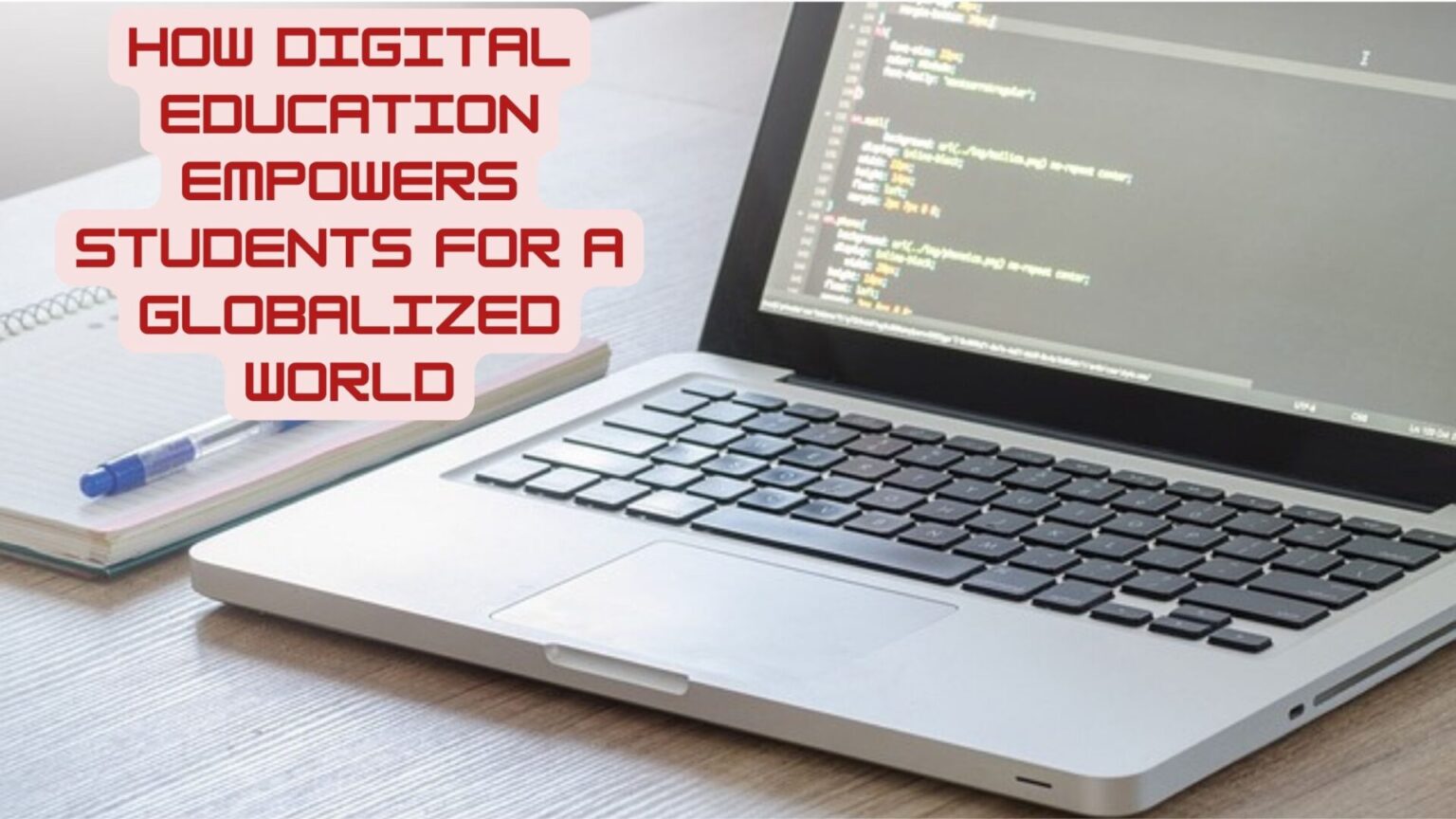Introduction:
In today’s interconnected world, digital education has emerged as a powerful tool for preparing students to thrive in a globalized society. This article explores the transformative impact of digital education on student empowerment, equipping them with the necessary skills, knowledge, and cultural competence to succeed in an increasingly interconnected world.
What is Digital Education?

- Bridging the Gap: Digital Education and Globalization In an era defined by globalization, digital education serves as a bridge that connects students to a vast array of cultures, perspectives, and opportunities. Through virtual classrooms, online collaborations, and interactive learning platforms, students gain a global perspective, breaking down geographical boundaries and fostering cross-cultural understanding.
- Developing Essential Skills for Global Competence Digital education goes beyond traditional teaching methods by nurturing essential skills required for success in a globalized world. Students develop critical thinking, problem-solving, and communication skills while engaging in collaborative online projects. They also learn to leverage technology effectively, adapt to diverse work environments, and embrace lifelong learning, enabling them to navigate the ever-evolving global landscape.
- Cultivating Cultural Competence through Digital Education In a globalized world, cultural competence is vital for effective communication and collaboration. Digital education exposes students to diverse cultures, traditions, and perspectives, promoting empathy, tolerance, and appreciation for diversity. Through virtual exchange programs and online cultural exchanges, students gain firsthand experiences that prepare them to engage respectfully and harmoniously with individuals from various backgrounds.
- Embracing Innovation: Technology in Digital Education Digital education harnesses the power of technology to deliver dynamic and immersive learning experiences. From virtual reality simulations to interactive multimedia resources, technology enhances student engagement and comprehension. Moreover, it prepares students to adapt to technological advancements, such as artificial intelligence and automation, which are shaping the future of the global workforce.
- Overcoming Barriers: Accessibility and Inclusivity One of the greatest advantages of digital education is its ability to overcome barriers to education, providing equal opportunities for students worldwide. Online learning platforms ensure that education is accessible regardless of geographical location or socio-economic status. By promoting inclusivity, digital education paves the way for a more equitable global society, where education is a fundamental right for all.
What is the role of digital education in transforming education?
Digital education plays a pivotal role in transforming education by revolutionizing the way knowledge is accessed, shared, and experienced. Here are some key roles that digital education fulfills in transforming education:

- Enhancing Access and Inclusivity: Digital education breaks down geographical barriers and provides access to quality educational resources and opportunities for learners worldwide. It ensures that education is not limited by physical constraints, enabling students from diverse backgrounds to access educational materials and connect with teachers and peers.
- Enabling Personalized Learning: Digital education facilitates personalized learning experiences tailored to individual students’ needs, interests, and learning styles. Through adaptive learning technologies and intelligent algorithms, students can progress at their own pace, receiving targeted support and resources that cater to their specific strengths and weaknesses.
- Fostering Collaborative Learning: Digital education promotes collaboration and interactive learning environments. Students can engage in virtual group projects, online discussions, and collaborative platforms, fostering teamwork, communication skills, and global perspectives. It encourages active participation and knowledge sharing among students, transcending traditional classroom boundaries.
- Empowering Self-Directed Learning: Digital education empowers learners to take ownership of their learning journeys. With vast online resources, open educational materials, and e-learning platforms, students can explore diverse subjects, pursue their interests, and engage in self-directed study. This autonomy cultivates critical thinking, problem-solving skills, and a lifelong love for learning.
- Integrating Multimodal and Interactive Content: Digital education utilizes multimedia resources, such as videos, interactive simulations, virtual reality, and gamification, to enhance engagement and understanding. Visual and interactive content helps students grasp complex concepts, stimulate curiosity, and retain information more effectively, creating immersive learning experiences.
- Promoting Technological Literacy and Digital Skills: Digital education equips students with essential technological literacy and digital skills required in the modern workforce. It prepares them to navigate digital tools, platforms, and emerging technologies, fostering digital fluency, creativity, and adaptability to future advancements.
- Supporting Continuous Professional Development: Digital education extends beyond traditional K-12 education and embraces lifelong learning. It provides opportunities for teachers and professionals to engage in online courses, webinars, and communities of practice, enabling continuous professional development to stay updated with the latest pedagogical practices and subject knowledge.
Overall, digital education acts as a catalyst for educational transformation by expanding access, personalizing learning experiences, fostering collaboration, and equipping learners with the skills necessary to thrive in a digital and interconnected world.
What kind of mind set is necessary for the students to get digital education for the global world?
To thrive in a global world through digital education, students need to cultivate a specific mindset that prepares them for the challenges and opportunities of an interconnected and rapidly changing environment. Here are some key mindsets that digital education students can develop:

- Open-mindedness: Students should embrace diversity and possess an open mind to different cultures, perspectives, and ideas. Being receptive to new experiences and willing to challenge preconceived notions allows for cross-cultural understanding and collaboration in a globalized context.
- Adaptability: The digital world is dynamic, and students need to be adaptable to technological advancements, changing work environments, and evolving learning platforms. Embracing change, being flexible, and embracing new technologies and tools are essential for success in the digital age.
- Curiosity and Lifelong Learning: Cultivating a sense of curiosity and a thirst for knowledge is crucial in a global world. Students should have a passion for continuous learning, exploring new subjects, and seeking out diverse sources of information. This mindset fosters intellectual growth and keeps students updated with the latest developments.
- Global Awareness: Developing a global mindset involves being aware of global issues, trends, and challenges. Students should stay informed about current events, global economies, environmental concerns, and cultural dynamics to understand the interconnectedness of the world and their role within it.
- Collaboration and Communication: Digital education offers opportunities for collaboration and requires effective communication skills. Students should be comfortable working in virtual teams, communicating across cultures, and leveraging technology to connect and share ideas effectively.
- Critical Thinking and Problem Solving: Digital education empowers students to think critically, analyze information, and solve complex problems. Developing a mindset that questions assumptions, seeks evidence, and evaluates different perspectives enables students to navigate the complexities of the global world.
- Resilience and Perseverance: The global world can present challenges, setbacks, and obstacles. Students need resilience to bounce back from failures, adapt to unexpected situations, and persevere in the face of difficulties. A growth mindset that embraces challenges and sees them as opportunities for growth is crucial.
- Entrepreneurial Mindset: Students can develop an entrepreneurial mindset, which includes creativity, innovation, and an ability to identify and seize opportunities. This mindset fosters an entrepreneurial spirit, adaptability to changing markets, and an inclination towards problem-solving and finding creative solutions.
By cultivating these mindsets, students can harness the power of digital education to prepare themselves for a globalized world. They will be better equipped to navigate diverse cultures, work collaboratively across borders, embrace technological advancements, and contribute positively to a global society.
Conclusion:
Digital education has revolutionized the way students prepare for a globalized world. By unleashing their potential, it equips them with the necessary skills, cultural competence, and adaptability required to succeed in an interconnected and ever-changing landscape. As we embrace the transformative power of digital education, we empower the next generation of global leaders who will shape a more inclusive, collaborative, and prosperous future for all.
FAQs:
Q1: What is digital education? A1: Digital education, also known as e-learning or online learning, refers to the use of digital technologies such as computers, tablets, smartphones, and the internet to deliver educational content and facilitate learning experiences.
Q2: How does digital education empower students for a globalized world? A2: Digital education provides students with access to a vast array of resources, enables collaborative learning across geographical boundaries, fosters digital literacy and 21st-century skills, and prepares them for careers in a globalized economy.
Q3: What are some examples of digital education tools and platforms? A3: Examples include learning management systems (LMS) like Moodle and Canvas, video conferencing tools like Zoom and Microsoft Teams, online course platforms like Coursera and Khan Academy, and educational apps for smartphones and tablets.
Q4: How does digital education promote cultural exchange and understanding? A4: Through online collaboration and communication tools, students can interact with peers from different cultural backgrounds, participate in virtual exchange programs, and access diverse perspectives and resources, thus fostering cultural awareness and empathy.
Q5: What are the challenges of implementing digital education in a globalized context? A5: Challenges include disparities in access to technology and the internet, digital literacy gaps, concerns about the quality and credibility of online content, and the need for teacher training and support in integrating technology effectively into teaching practices.
References:
- Bates, T. (2015). Teaching in a Digital Age: Guidelines for Designing Teaching and Learning. Retrieved from https://opentextbc.ca/teachinginadigitalage/
- OECD. (2015). Students, Computers and Learning: Making the Connection. Retrieved from https://www.oecd-ilibrary.org/education/students-computers-and-learning_9789264239555-en
- UNESCO. (2019). IITE Policy Brief: Digital Pedagogy in Primary Education. Retrieved from https://iite.unesco.org/publications/3214683/
- Voogt, J., & Knezek, G. (Eds.). (2018). International Handbook of Information Technology in Primary and Secondary Education. Springer International Publishing.
- Warschauer, M. (2003). Technology and Social Inclusion: Rethinking the Digital Divide. MIT Press.






